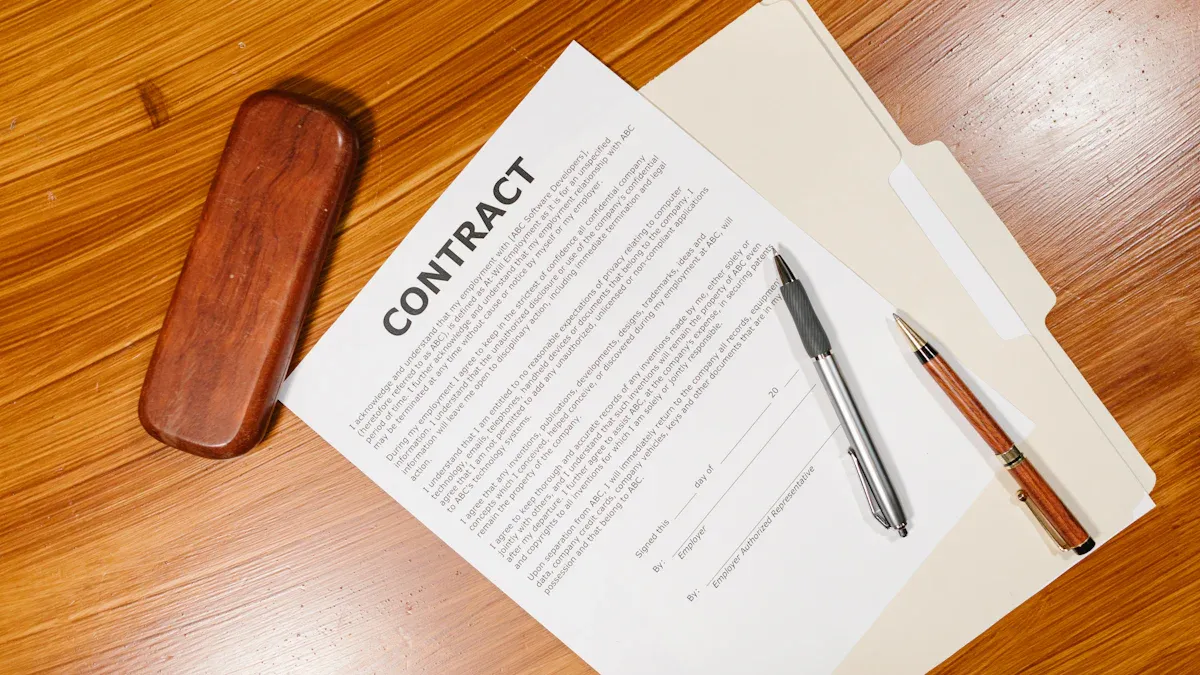Image Source: pexels
From Lawyer’s Perspective: Efficient Handling of Complex Personal Injury Cases, success hinges on the ability to overcome challenges such as conducting thorough investigations, managing client expectations, and balancing financial risks. These obstacles require strategic thinking and precise execution. By adopting streamlined processes and effectively utilizing expert witnesses, lawyers can navigate the intricacies of these cases and achieve the best possible outcomes for their clients.
Key Takeaways
- Knowing how tricky personal injury cases can be helps you plan. Things like carelessness and old injuries can make claims harder.
- Being quick and organized is important for tough cases. Collecting proof fast and keeping things simple saves time and helps you win.
- Talking openly with your lawyer makes things easier. Sharing updates and all needed details helps the process go smoothly.
What Defines a Complex Personal Injury Case?
Key Factors Contributing to Complexity
Not all personal injury cases are straightforward. Some involve layers of complexity that demand careful navigation. Several factors can make a case more challenging to handle:
- Negligence: Determining who is at fault can become a contentious issue, especially when multiple parties are involved.
- Pre-existing conditions: If you have a prior injury or medical condition, it may complicate your claim. For example, an aggravated back injury could lead the defendant to argue that the accident didn’t cause your pain.
- Severity of injuries: Long-term or permanent injuries often require extensive documentation to justify higher compensation.
- Impact of property damage: Significant damage to vehicles or other property can influence both compensation and fault determination.
Each of these factors can add layers of difficulty to your case. For instance, pre-existing conditions might require additional medical evidence to prove that the accident worsened your health. Similarly, severe injuries often lead to disputes over the extent of future medical expenses or loss of quality of life. Addressing these complexities requires a strategic approach and meticulous preparation.
Examples of Complex Cases and Their Unique Challenges
Some personal injury cases stand out due to their inherent complexity. For example, multi-vehicle accidents often involve multiple insurance companies and conflicting accounts of what happened. You may find yourself navigating a maze of claims and counterclaims.
Medical malpractice cases also present unique challenges. Proving negligence in these cases requires expert testimony and detailed medical records. If you’re dealing with a misdiagnosis or surgical error, you’ll need to demonstrate how the healthcare provider’s actions directly caused harm.
Another example includes workplace injuries involving third-party liability. Imagine you’re injured by defective equipment at work. In this scenario, you might need to pursue claims against both your employer and the equipment manufacturer. These overlapping claims can complicate the legal process.
Understanding what makes a case complex helps you prepare for the road ahead. By recognizing these challenges early, you can work with your lawyer to build a strong, efficient strategy.
The Importance of Efficiency in Complex Cases
How Efficiency Impacts Case Outcomes
Efficiency plays a pivotal role in determining the success of complex personal injury cases. When you streamline processes, you reduce delays and ensure that every aspect of your case receives the attention it deserves. This approach not only saves time but also strengthens your position during negotiations or in court.
For instance, gathering evidence promptly and organizing it systematically can prevent critical details from being overlooked. A well-prepared case file demonstrates professionalism and readiness, which can influence opposing parties to settle more favorably. Additionally, efficient handling of legal procedures minimizes the risk of missing deadlines, which could otherwise jeopardize your claim.
From Lawyer’s Perspective: Efficient Handling of Complex Personal Injury Cases often involves balancing multiple moving parts. By prioritizing efficiency, you give your lawyer the tools they need to focus on building a compelling argument, rather than wasting time on avoidable setbacks.
Managing Time, Resources, and Client Expectations
Managing time and resources effectively begins with a strategic intake process. Screening potential cases ensures that only those with strong merit move forward. This allows your lawyer to allocate their time and resources to cases with the highest likelihood of success.
To manage expectations, you should:
- Use performance ranges and timelines to set realistic goals.
- Back up claims with case studies or proven results to avoid overpromising.
- Clearly explain the legal process and its potential challenges.
Regular communication is another cornerstone of efficiency. Your lawyer should define specific communication channels early on to streamline interactions. Setting realistic milestones and updating you proactively builds trust and keeps you informed.
From Lawyer’s Perspective: Efficient Handling of Complex Personal Injury Cases also requires setting boundaries. A clear Statement of Work (SoW) defines the scope of the case, preventing misunderstandings or scope creep. Charging hourly for out-of-scope work ensures that resources remain focused on the primary objectives.
By embracing these practices, you and your lawyer can work together to achieve the best possible outcome for your case.
Strategies for Efficient Handling of Complex Personal Injury Cases
Comprehensive Evidence Collection and Documentation
Building a strong case starts with gathering and organizing evidence effectively. You must act quickly to preserve critical details that support your claim. Here’s how you can ensure thorough evidence collection:
- Act Promptly and Preserve Evidence: Take photos of the accident scene, collect witness information, and secure any physical evidence before it’s lost.
- Document Your Damages and Losses: Keep a journal to record how the injury affects your daily life. Save receipts, medical bills, and employment records to demonstrate financial and emotional impacts.
- Obtain Medical Documentation: Seek medical attention immediately and maintain detailed records of treatments and expenses.
- Secure Witness Testimony: Identify witnesses and document their statements to strengthen your case.
- Obtain Police and Incident Reports: Request official reports to provide an unbiased account of the incident.
From Lawyer’s Perspective: Efficient Handling of Complex Personal Injury Cases, this step ensures that no critical detail is overlooked, giving your lawyer the tools to build a compelling argument.
Strategic Legal Planning and Case Management
Strategic planning is the backbone of handling complex cases efficiently. Your lawyer must define success early and align strategies with your goals. Key components of effective planning include:
- Setting clear objectives, such as favorable outcomes, cost-effective resolutions, or reputation management.
- Conducting early case assessments (ECA) to evaluate risks, control costs, and streamline the legal process.
- Leveraging technology like generative AI to analyze data, simulate scenarios, and make informed decisions.
By focusing on these elements, your lawyer can navigate the complexities of your case while keeping resources and timelines in check.
Clear and Consistent Client Communication
Effective communication ensures that you stay informed and aligned with your lawyer throughout the process. Clear communication builds trust and prevents misunderstandings. Here’s how you can foster this:
- Establish preferred communication channels early, such as email or scheduled calls.
- Request regular updates on case progress and milestones.
- Share all relevant information promptly to avoid delays.
From Lawyer’s Perspective: Efficient Handling of Complex Personal Injury Cases, maintaining open communication helps you and your lawyer work as a team, ensuring a smoother path to resolution.
Overcoming Challenges in Complex Personal Injury Cases
Navigating Multiple Stakeholders and Parties
Handling cases with multiple stakeholders can feel like juggling several moving parts. You must address the interests of all parties while ensuring your claim remains strong. Lawyers often face challenges such as conflicting priorities, miscommunication, and prolonged negotiations. To overcome these, they rely on strategies that promote collaboration and clarity:
- Maintain meticulous communication to keep all parties informed and aligned.
- Seek compromise by identifying common ground, as no party will likely get everything they want.
- Use impartial mediation to encourage constructive dialogue and reduce tension.
- Leverage group decision-making tools to streamline discussions and avoid misunderstandings.
- Assemble a multidisciplinary legal team to cover every aspect of the case comprehensively.
By adopting these approaches, your lawyer can navigate the complexities of multiple stakeholders while keeping your best interests at the forefront.
Addressing Medical and Legal Complexities
Complex personal injury cases often involve intricate medical and legal issues. Your lawyer must carefully analyze evidence, calculate damages, and challenge low settlement offers. Here’s how they tackle these challenges:
| Step | Description | Tools |
|---|---|---|
| Gathering Evidence | Collecting and documenting pertinent information post-accident. | Cameras, witness forms |
| Storing Evidence | Ensuring evidence is kept securely and is easily retrievable. | Secure clouds, database systems |
| Analyzing Evidence | Reviewing and interpreting the collected data to support claims. | Legal software, expert analysis |
Additionally, understanding policy limits and valuing claims accurately ensures you receive fair compensation. If negotiations fail, litigation may become necessary. While time-consuming, it demonstrates your commitment to justice and can lead to a favorable outcome.
Mitigating Delays and Unexpected Obstacles
Delays and unforeseen challenges can derail even the strongest cases. To stay ahead, you and your lawyer must anticipate potential issues and act proactively:
- Identify obstacles early using tools like SWOT analysis and risk registers.
- Create a realistic schedule with clear benchmarks to track progress.
- Communicate frequently to manage expectations and resolve conflicts quickly.
- Build strong relationships with stakeholders to navigate challenges effectively.
By staying vigilant and adaptable, you can minimize disruptions and keep your case on track. These strategies ensure that unexpected hurdles don’t compromise your pursuit of justice.
How Clients Can Support Their Lawyer’s Efforts
Keeping Detailed Records and Documentation
Your ability to maintain detailed records can significantly impact the success of your case. Start by documenting every aspect of the incident. Take photos of the accident scene, your injuries, and any property damage. Save receipts for medical expenses, repair costs, and other related expenditures. Keep a journal to track how the injury affects your daily life, including pain levels, missed workdays, and emotional struggles.
Organized documentation makes it easier for your lawyer to build a strong case. It also prevents opposing parties from questioning the validity of your claims. By staying proactive, you ensure that no critical detail gets overlooked.
Avoiding Common Mistakes That Can Weaken a Case
Avoiding common pitfalls is just as important as taking the right steps. Many clients unintentionally weaken their cases by making avoidable errors:
- Not seeking immediate medical attention can lead insurance companies to argue that your injuries are unrelated to the accident.
- Failing to document evidence, such as photographs or witness statements, can make it harder to prove your claim.
- Speaking directly to insurance adjusters without legal representation can result in statements being used against you.
- Ignoring medical advice or skipping follow-up appointments may suggest that your injuries are not serious.
By steering clear of these mistakes, you protect the integrity of your case and strengthen your lawyer’s ability to advocate for you.
Maintaining Open and Transparent Communication
Open communication with your lawyer builds trust and ensures a smoother process. When you share all relevant details, your lawyer can tailor strategies to meet your needs. Regular updates keep you informed about progress and potential challenges. This transparency fosters a strong partnership, which is essential for navigating complex cases effectively.
Trust and collaboration thrive on clear communication. By staying honest and engaged, you empower your lawyer to achieve the best possible outcome for your case.
Navigating Insurance Company Negotiations

Image Source: pexels
Understanding the Role and Tactics of Insurance Companies
Insurance companies play a central role in personal injury cases. They evaluate claims, determine compensation, and negotiate settlements. However, their primary goal is to protect their bottom line, often at your expense. You need to understand their tactics to avoid falling into their traps.
Here are some common strategies insurers use:
- Pressuring you to admit fault or share unnecessary details.
- Disputing the severity of your injuries or their connection to the accident.
- Withholding critical information or ignoring evidence you provide.
- Misrepresenting policy coverage to limit payouts.
- Delaying the claims process to frustrate you into accepting less.
- Offering lowball settlements, hoping you’ll accept without question.
Recognizing these tactics empowers you to stay one step ahead and protect your rights.
Effective Strategies for Negotiating Settlements
Negotiating with insurance companies requires preparation and persistence. To secure a fair settlement, you should:
- Gather comprehensive documentation, including medical records, receipts, and photos.
- Avoid giving recorded statements without consulting your lawyer.
- Stay firm against low initial offers and counter with evidence-backed demands.
- Highlight the long-term impact of your injuries, such as lost wages or ongoing medical care.
Having a personal injury lawyer can significantly strengthen your position. Lawyers understand insurance laws and negotiation tactics. They can build a compelling case and even threaten litigation if necessary, often prompting insurers to offer better settlements.
Avoiding Common Pitfalls in Insurance Claims
Mistakes during the claims process can weaken your case. Avoid these common pitfalls:
- Failing to seek immediate medical attention. This can make your injuries seem less serious.
- Neglecting to document the accident thoroughly. Photos, witness statements, and police reports are essential.
- Accepting the first settlement offer without consulting a lawyer. Initial offers rarely reflect the true value of your claim.
Tip: Stay proactive and informed. By avoiding these errors, you increase your chances of receiving the compensation you deserve.
Efficient handling of complex personal injury cases requires a strategic approach. From Lawyer’s Perspective: Efficient Handling of Complex Personal Injury Cases, experienced legal representation is crucial. Skilled lawyers:
- Secure fair compensation by addressing all damages, including future income loss.
- Protect you from intimidation tactics by employers or insurers.
- Ensure compliance with legal deadlines and manage negotiations effectively.
You can support your lawyer by taking these steps:
- Prepare and organize all case-related information.
- Be transparent and share every detail, even unfavorable ones.
- Establish clear communication channels and respect professional boundaries.
By working collaboratively, you strengthen your case and improve your chances of a favorable outcome.
FAQ
What should you do immediately after a personal injury accident?
- Seek medical attention right away.
- Document the scene with photos and witness details.
- Contact a personal injury lawyer for guidance.
Tip: Acting quickly preserves evidence and strengthens your case.
How long does it take to resolve a complex personal injury case?
Resolution times vary. Some cases settle in months, while others take years, especially if litigation is involved. Your lawyer can provide a realistic timeline.
Can you handle a personal injury case without a lawyer?
You can, but it’s risky. Complex cases require legal expertise to navigate negotiations, evidence, and court procedures. Hiring a lawyer increases your chances of fair compensation.
Note: Insurance companies often exploit unrepresented claimants. Protect your rights with professional help.




